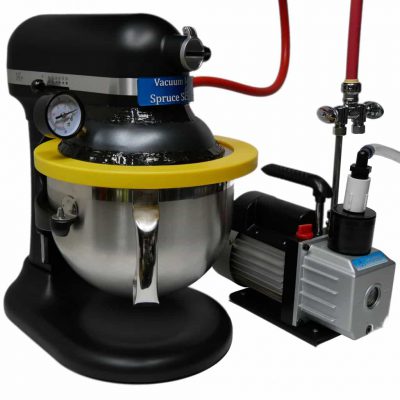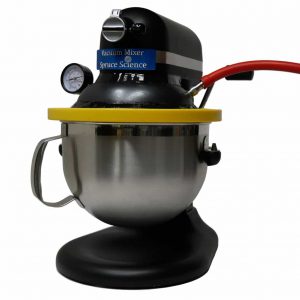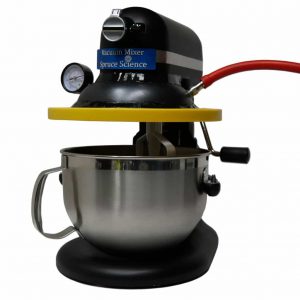Revolutionize Your Sausage Making with a Vacuum Mixer
Demonstration Notes
Introduction
Check out our video demonstration on the bottom of this page or on our YouTube channel to see how we used the Vacuum Mixer from Spruce Science to make delicious, high-quality sausages without relying on unhealthy food preservatives. The vacuum mixer could be the future of healthy, preservative-free food and the gateway to discovering new and exciting flavors and food products. With its ability to mix materials under reduced atmospheric pressure and prevent unwanted reactions with atmospheric gases, the vacuum mixer is a valuable tool for creating tasty and healthy dishes. Be sure to watch our video to see the feasibility of using the vacuum mixer for sausage making and get inspired to revolutionize your own culinary creations.
Sausages are a universal food, loved for their versatility, flavor, and convenience. Whether grilled, fried, boiled, or smoked, these succulent links of ground meat have a rich, savory taste that speaks to our primal cravings. And with so many different varieties available, from spicy chorizo to herby bratwurst, there’s a sausage out there for every palate. Plus, they’re cheap, easy to store, and can be thrown into just about any dish as a quick protein boost. But don’t just take my word for it – grab a pack of your favorite sausages and get cooking. Trust me, your stomach (and taste buds) will thank you.
Sausages have been a part of human history for thousands of years, with evidence of sausage-like products dating back to ancient civilizations in Egypt, Greece, and Rome. These savory treats are made from ground meat and typically seasoned with a variety of spices and herbs, with the type of meat and spices used varying widely depending on the region and culture. Sausages can be made from a wide range of meats, including pork, beef, chicken, turkey, and lamb, and there are even vegetarian and vegan options made from plant-based proteins like tofu and tempeh. The word “sausage” itself comes from the Latin “salsus,” meaning “salted,” a reference to the original method of preserving meat through salting. And with so many different regional variations, it’s no surprise that sausages are enjoyed all around the world – from Italian sausages and German bratwurst, to Spanish chorizo and French andouille. These delicious links can be grilled, fried, boiled, or smoked, and can be eaten on their own or used as an ingredient in dishes like sausage and peppers, sausage and eggs, or sausage gravy. And with such a long and varied history, it’s clear that sausages are here to stay.
The humble sausage has a rich history, and one interesting story involves the creation of a dish called “chipped beef on toast” or “SOS” during World War II. This dish, consisting of thin slices of dried beef served on toast and covered in a creamy white sauce, was often referred to as “Shit on a Shingle” by soldiers due to the acronym’s similarity to the dish’s name. Originally created as a way to stretch rations and make use of lower-quality cuts of meat, this dish became a staple of military cuisine during the war. And though it may have humble origins, chipped beef on toast remains a popular breakfast dish in the United States to this day. Who would’ve thought that a simple sausage could have such a storied past?
Science
When it comes to sausage making, there’s more to it than just mixing some ground meat and spices together. Science plays a big role in the process, from the use of curing agents and microorganisms to preserve and flavor the meat, to the physical and chemical changes that occur during the cooking process. Curing agents like salt and sodium nitrite help to preserve the meat and prevent the growth of harmful bacteria, while also contributing to the sausage’s flavor and color. And don’t forget about the role of microorganisms like bacteria and fungi in fermenting the sausage and adding to its flavor. The physical structure of the sausage is also important, with factors like the grinding and mixing of the meat and other ingredients, as well as the use of a casing to hold everything together, all impacting the final product. And let’s not forget the cooking process – the type of heat and cooking method used can affect the rate at which the sausage cooks and the final texture of the meat, whether it’s grilled, smoked, boiled, or fried. So the next time you sink your teeth into a juicy sausage, remember all the science that went into making it.
Preservatives
When it comes to sausage making, preservatives are often used to extend the shelf life and improve the flavor of the final product. Some common preservatives include salt, which helps to inhibit the growth of bacteria and add flavor to the sausage, and sodium erythorbate, a synthetic compound that reduces the curing time and enhances the flavor of processed meats like hot dogs and bacon. Sodium nitrite is another common curing agent used in sausage making, helping to preserve the color and flavor of the meat and prevent the growth of harmful bacteria. And let’s not forget about sodium tripolyphosphate, a synthetic compound used to retain moisture in processed meats like ham and bacon and improve their texture. While these preservatives can be useful in small amounts, it’s important to note that some have been linked to potential health risks when consumed in excess. That’s why it’s always a good idea to choose sausages with fewer additives and preservatives when possible.
Health Concerns
Sausages can be a tasty and convenient part of a healthy diet in moderation, but it’s important to be aware of the potential health risks that can come with eating them in excess. Many sausages are high in saturated fat, which can increase the risk of heart disease and other health problems, and they are often high in sodium, which can contribute to high blood pressure and other issues. Additionally, there is a risk of food poisoning from sausages that are not cooked to a safe temperature or handled properly, due to the presence of harmful bacteria such as salmonella or E. coli. And let’s not forget about the possible presence of additives like preservatives or artificial flavorings, which may pose potential health risks if consumed in excess. To reduce these potential health risks, it’s a good idea to choose lean cuts of meat, opt for sausages with fewer additives and preservatives, and consume them in moderation as part of a balanced diet. After all, a little sausage goes a long way.
Vacuum Mixer
If you’re looking to revolutionize your sausage making, consider using a vacuum mixer like the one from Spruce Science. This powerful tool allows you to mix a wide range of materials under reduced atmospheric pressure, eliminating the incorporation of air bubbles and preventing unwanted secondary reactions with atmospheric gases. By mixing your sausage seasoning under vacuum, you can achieve a deeper penetration of flavor into the meat and prevent oxidation, resulting in fresher-tasting food without the need for preservatives. The vacuum mixer from Spruce Science is flexible and can mix materials with varying consistencies and viscosities, making it suitable for a wide range of applications. Plus, with the ability to prevent bubble formation and eliminate the underlying problem of air bubbles, you can achieve more consistent results and improved food quality and performance. So why not give the vacuum mixer a try and see what new and delicious sausage creations you can come up with?
Recipe
Here is a basic recipe for making sausage at home with the vacuum mixer:
Ingredients:
- 2 lbs ground pork
- 2 tsp salt
- 1 tsp black pepper
- 1 tsp paprika
- 1 tsp garlic powder
- 1 tsp onion powder
- 1/2 tsp dried basil
- 1/2 tsp dried oregano
- 1/2 tsp dried thyme
- Natural hog casings (optional)
Instructions:
- In the vacuum mixer mixing bowl, combine the ground pork and spices. Use the vacuum mixer to mix well to evenly distribute the spices.
- If using natural hog casings, rinse the casings thoroughly in cold water and soak in a bowl of warm water for at least 15 minutes.
- Place the sausage mixture in a sausage stuffer or use a spoon to fill the hog casings, leaving enough space at the ends to tie them off.
- Tie off the ends of the hog casings using butcher’s twine or a knot.
- Preheat a grill, stovetop grill pan, or oven to 350°F (175°C).
- Place the sausages on the grill or in the grill pan and cook for 15-20 minutes, turning occasionally, until the internal temperature reaches 160°F (71°C).
- Alternatively, you can bake the sausages in the oven for 20-25 minutes, or until the internal temperature reaches 160°F (71°C).
- Serve the sausages hot, or store them in the refrigerator or freezer for later use.
Note: This recipe can be modified by using different types of ground meat and spices to suit your preference. You can also omit the hog casings and shape the sausage mixture into patties or meatballs.
Video Demonstration





